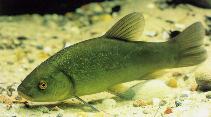| Family: |
Tincidae (Tenches) |
| Max. size: |
70 cm SL (male/unsexed); max.weight: 7,500.0 g |
| Environment: |
demersal; freshwater; brackish; depth range - 1 m, potamodromous |
| Distribution: |
Eurasia: hypothesized as native in most Europe, naturally absent only in Ireland, Scandinavia north of 61°30'N, eastern Adriatic basin and western and southern Greece where it is now introduced. In Asia, native eastward to western Yenisei drainage south of 60° N. Introduced elsewhere. |
| Diagnosis: |
Dorsal spines (total): 4-4; Dorsal soft rays (total): 8-9; Anal spines: 3-4; Anal soft rays: 6-8; Vertebrae: 39-41. Body thickset, heavy, and laterally compressed, the caudal peduncle characteristically deep and short. Skin thickened, slimy; the scales small, embedded. Overall coloration olive-green, at times dark green or almost black, with golden reflections on ventral surface. Head triangular, eye orange-red, small; snout relatively long; interorbital broad; mouth terminal, small in size with thick lips and a pair of well-developed barbels, one at each corner of the mouth. Caudal fin with 19 rays (Ref. 2196). Diagnosed from other cyprinid species in Europe by the following characters: body golden greenish brown; one pair of barbel (maxillary); lateral line with 96-115 scales, small and deeply embedded; dorsal fin with 8-9½ branched rays; and anal fin with 6-9½ branched rays (Ref. 59043). |
| Biology: |
Typically found in shallow, densely vegetated lakes and backwaters. Often overwinters buried in mud. Larvae and juveniles confined to dense vegetation (Ref. 59043). Adults inhabit warm lakes and pools with weed and mud bottom. Tolerates low oxygen saturations (Ref. 30578, 44894). Feeds on detritus, benthic animals and plant materials. Adult often prey mainly on molluscs. Spawns among dense vegetation in still water (Ref. 59043). Used as a fodder fish for bass (Ref. 7248). Utilized fresh and frozen; eaten pan-fried, broiled, and baked (Ref. 9988). Popular with amateur sport fishers. Its flesh is highly esteemed (Ref. 30578). Locally under threat due to river engineering (Ref. 59043). Reported to reach a maximum length of 84 cm TL (Ref. 5723). |
| IUCN Red List Status: |
Least Concern (LC); Date assessed: 01 January 2008 Ref. (130435)
|
| Threat to humans: |
harmless |
Source and more info: www.fishbase.org. For personal, classroom, and other internal use only. Not for publication.
